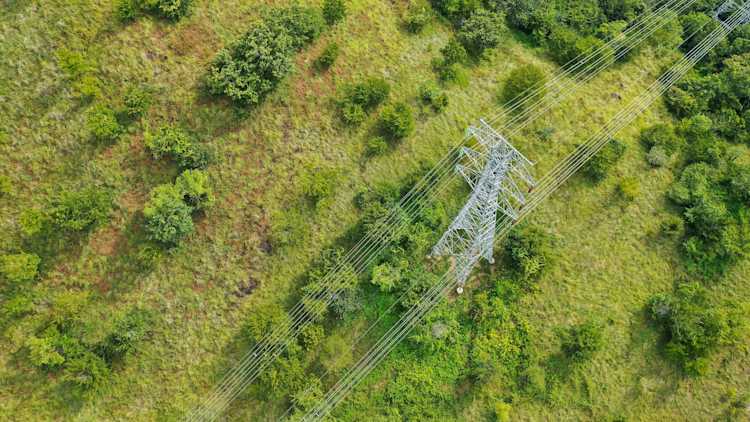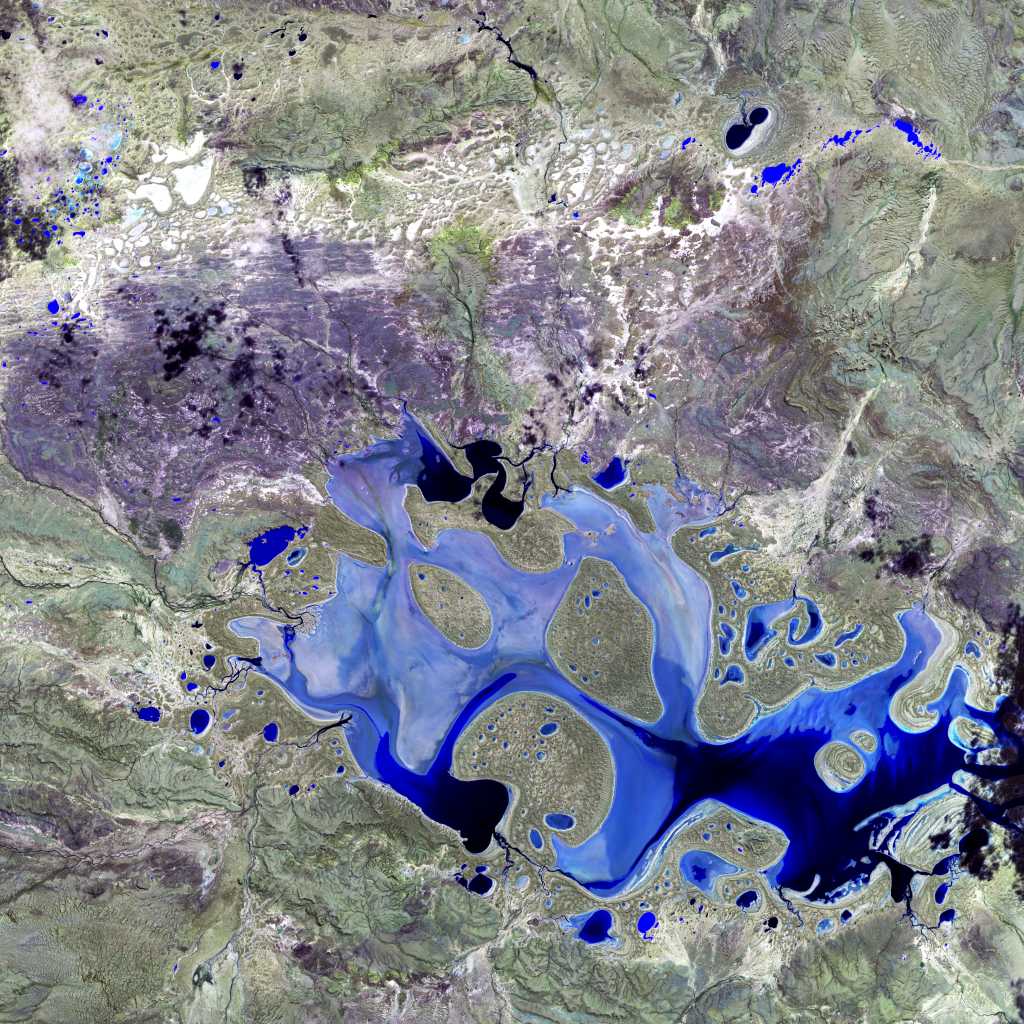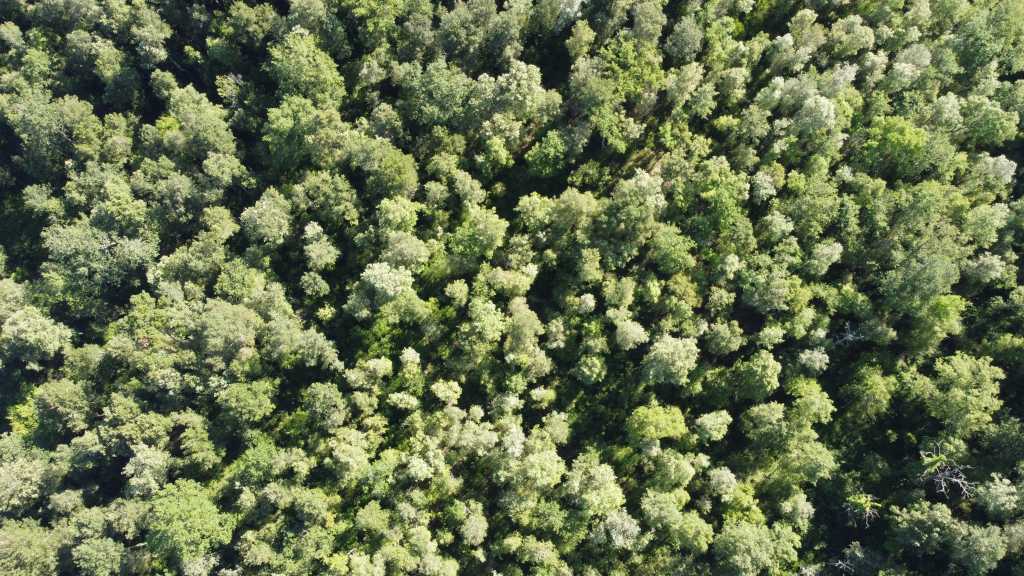Editor's note: this article was originally published on April 16th, 2021, by Nikita Marwaha Kraetzig. It was updated on April 4th, 2025 by Kevin Enright.
Best estimate: the world today has about 1, 374, 000 km of train tracks, and over 80 million kilometers of power lines. Plenty of this infrastructure runs through forests, mountains, and other remote areas, which makes it tough to monitor through in-person efforts.
But fortunately, we have other tools at our disposal. Remotely monitoring infrastructure with geospatial data makes keeping a close eye on things easier and more affordable.
Satellites, aerial platforms (including planes, drones, and stratospheric balloons), and change detection algorithms can all help. But first, let’s take a look at vegetation management and infrastructure maintenance and why they're so important.
What is vegetation management?
Vegetation management is the targeted control and elimination of unwanted or dangerous plant growth.
Encroaching vegetation poses major risks to power lines, railways, and other types of infrastucture, and can easily cost millions of dollars or more in damages.
Why is vegetation management important?
Some of the recent wildfires in California are an example of why vegetation management is so important.
It's suspected that the Eaton Fire in LA County, in particular, was caused by a mix of high-speed winds and dry vegetation around power lines.
In areas that face drought conditions, the removal of weeds and vegetation may be required by law. For example, some parts of California mandate that residents and businesses clear weeds and brush from their properties.
The importance of vegetation management also extends to rail infrastructure.
Rail lines, roads, and factories all need vegetation management to ensure system reliability and safety. As climate change worsens conditions and causes major storms, vegetation management following a storm is increasingly crucial to safeguarding impacted communities.
 The MTA NYC Transit team deployed thousands of personnel to repair storm damage after tropical storm Isaias on 4 August, 2020. The storm brought rain and high winds and caused a large tree to fall across three train tracks.
The MTA NYC Transit team deployed thousands of personnel to repair storm damage after tropical storm Isaias on 4 August, 2020. The storm brought rain and high winds and caused a large tree to fall across three train tracks.
It's also important for buildings: unwanted vegetation can serve as harborage areas for birds, rodents, and insects. And the longer these animals stay, the more difficult and expensive they are to remove.
Weeds can also spread in the form of harmful plants such as poison ivy, thorn-covered vegetation, and invasive plant species. As well as the obvious health threat, plants can also cause structural damage, such as climbing vines that push gutters off buildings or widen small cracks in walls.
Removing them enhances your overall property or asset safety. Clearing away brush, ground cover, and weeds reduces the risk of injury due to unseen hazards. It also makes maintenance easier and helps improve visibility for security efforts.
Types of vegetation management
Hazardous tree removal
A tree is considered to be hazardous when it is unhealthy and has the potential to fall on a powerline. Removing hazardous trees prevents them from hitting train tracks or power lines, preventing accidents, blackouts, and wildfires.
Tree pruning
With hazardous tree removal focusing on unhealthy trees,tree pruning maintains healthy trees that have the potential to grow close to power lines and other assets.
Direction pruning is the optimal method of tree pruning. It takes into account both the structural integrity and health of a tree—as opposed to other methods which can reduce structural integrity.
This method uses pruning to guide branches away from the area of concern being protected and reduces internal decay. Directional pruning also reduces the need for future pruning so can be seen as preventative management.

Brush removal
Low-lying brush has the potential to cause fires and outages when near power lines or other electrical infrastructure. Brush removal helps to reduce the level of risk, keeping communities safe. Brush can be removed using hand tools and then treated to prevent regrowth.
At the ground level, all flammable material in the vicinity will be removed—including brush, limbs and foliage of living trees.
Herbicides
Herbicides and weed control are used to remove unwanted vegetation. They either kill or suppress plants by interfering with essential plant processes such as photosynthesis.
Choosing not to implement herbicides can often be costly. The Centre for Energy and Advancement through Technological Innovation (CEATI) found that choosing not to use herbicides has doubled the cost of vegetation maintenance over the next 20 years.
Utility vegetation management
When it comes to vegetation management, it’s important to manage vegetation that overgrows and begins to encroach on utility right of way (ROW).
Utility ROW is a registered easement on private land that allows cities and utility companies the right to access the utilities or services that are present. Every utility that generates, stores, transports, or transmits energy has rights of way that are maintained.
Utility vegetation management methods are used to maintain utility ROW and control the growth of vegetation and reduce the risk of outages, fires, and other disruption and danger to the communities and the service the utility is providing.
These electric transmission line corridors are maintained to ensure safe, adequate clearances between energized conductors and vegetation—as well as to enable access to energy delivery infrastructure for inspection, maintenance, repair, and restoration of power, if a problem does occur.
 A utility right-of-way pass through trees in Corning, N.T
A utility right-of-way pass through trees in Corning, N.T
Why should utilities manage vegetation?
Efficient and timely asset management is always essential, but even more critical when assets include power lines that could spark a fire or outage due to overgrowth.
For utilities in the United States, vegetation management is the largest preventative maintenance expense. Exceeding $100 million annually at many larger utility companies, vegetation management remains the single largest line item in annual operations and maintenance budgets of most power utilities in the US.
However, it is worth noting that vegetation management is the greatest contributor to utility system reliability and outage management.
Outages cost an average of around $33 billion annually in the US alone. Additionally, scrutiny from customers, regulators, and the media has influenced utility companies to better understand the risk of liabilities.
 FirstEnergy utilities maintain vegetation under power lines to enhance service reliability for customers—using tree contractors to trim and manage vegetation for both distribution and transmission lines.
FirstEnergy utilities maintain vegetation under power lines to enhance service reliability for customers—using tree contractors to trim and manage vegetation for both distribution and transmission lines.
Want to learn more about utility vegetation management, specifically? We have a dedicated article on the topic.
What is infrastructure maintenance?
To understand infrastructure maintenance, we need to first familiarize ourselves with infrastructure asset management—the integrated, multidisciplinary set of strategies used to sustain public infrastructure.
Infrastructure asset management’s fundamental goal is to preserve and extend the service life of long-term infrastructure assets.
Infrastructure maintenance specifically intervenes at strategic points in an asset’s normal life cycle to maintain its performance.
Typically, a long-life-cycle asset requires multiple intervention points. This ranges from repair and maintenance activities to overhaul rehabilitation.
Infrastructure maintenance includes:
- Minor repairs (routine maintenance)
- Improvements (capital maintenance)
The latter is to eliminate the cause of defects and to avoid excessive repetition of routine maintenance efforts.
 Serbian Railways Infrastructure rail track maintenance machine in Čačak
Serbian Railways Infrastructure rail track maintenance machine in Čačak
Why is infrastructure maintenance important?
All infrastructural assets, however well designed and built, require maintenance and repair as they age.
From highway networks to airports, infrastructure connects communities and supports both economic and social growth.
In all these places, security and efficiency are paramount. Regular and thorough maintenance is required to maintain a safe environment. This is a continuous process and involves both remedial action for any faults detected and preventative measures.
Neglected infrastructure will result in asset degradation. This leads to negative effects on the economy and greater costs of reconstruction over time. Therefore, the goal of infrastructure maintenance is to preserve an asset, not to upgrade it.
This study refers to infrastructure maintenance as “a means of renewing the milieu of an infrastructure or way of retaining its value so it always serves the purpose for which it was procured.”
It highlights that infrastructure management (maintenance) is a great challenge facing sustainable development of infrastructure in Third World Cities.
Maintenance strategy is not incorporated into the whole-life-cycle costing of infrastructure development at the planning stage in developing nations, despite infrastructure being the foundation on which humanity depends on for successful living.
It highlights the importance of infrastructure maintenance and concluded that the lack of effective maintenance strategy and neglect causes a total breakdown of infrastructure facilities—including buildings, roads, lifts, aircrafts, airpots, telecommunication masts, trains, rail lines, and more.
Additionally, in the 21st century, climate change adaptation has become an important part of infrastructure asset management competence.
Climate change adaptation is the process of adjusting to current or expected climate change and its effects. Adaptation aims to moderate or avoid harm.
Actions taken to decrease climate vulnerability include building infrastructure that is more resistant to hazards, improving existing infrastructure, and moving infrastructure to less hazardous areas.
What types of infrastructure need to be maintained?
Infrastructure is defined as “the physical components of interrelated systems providing commodities and services essential to enable, sustain, or enhance societal living conditions” and maintain the surrounding environment (Fulmer, Jeffrey, 2009).
Public infrastructure is the foundation of society and our economies.
Serving a country, city, or other areas, infrastructure includes the services and facilities required for its economy to function.
Infrastructure that requires maintenance is composed of public and private structures such as the following:
Highways, streets, and roads
Highways, streets, and roads are a common type of infrastructure that often undergoes construction and maintenance.
Maintenance and repair projects can include street resurfacing, which is less expensive than street reconstruction, but is a temporary fix.
This study reports that maintaining existing transport networks and ensuring efficient transport infrastructure provides economic and social benefits to both advanced and emerging economics.
It does so by improving market accessibility and productivity, ensuring balanced regional economic development, creating employment, connecting communities, and promoting labour mobility.
Bridges
Bridges are a key part of infrastructure across the world. They connect land, people, and nations.
However, 4% of highway bridges carrying significant traffic are considered to be structurally deficient. This doesn’t mean they are unsafe, but that they require repairs.
Maintaining bridges can be a large undertaking, often with logistical complexity and higher expenses.
Airports
Airports are valuable hubs to communities and our global airspace. However, many airports are not updated for long periods of time and are in need of retrofitting.
ACI World highlighted the need for aviation infrastructure to mirror its demand from air services and passengers—stressing the need for quality and timely airport infrastructure.
Whether it’s to keep up with the pace of projected growth and interest of the traveling public, or to carry out routine maintenance—maintaining airports requires a combination of preventative and corrective practices.
Water supply and waste management
Waste management and water management is one of the most important types of infrastructure that require maintenance.
It involves the safe transportation of waste from residential and commercial areas. Waste products can include trash, wastewater, and recycling.
Removing waste cautiously keeps people safe and prevents the spread of disease and pests.
Infrastructure maintenance ensures safety standards are met and disruption is kept to a minimum for water supply and waste management processes.
Power generation and transmission
Infrastructure related to energy includes power generation plants, as well as facilities and structures needed to store and transmit power.
Since this kind of infrastructure is so critical to keeping countries running, keeping a close eye on how systems are performing and ensuring they are regularly maintained, is of key importance.
Power plant maintence refers to the maintenance oof assets and equipment, but also routine inspections, installation of equipment, systems review, and scheduled preventative maintenance.
For two great examples of power line infrastructure monitoring in action, check out our case studies with AiDash and Overstory.
Why should infrastructure be maintained?
The debate surrounding infrastructure maintenance is one of cost versus benefits.
It’s said that prevention is cheaper than cure. In turn, deferred maintenance is a borrowing time from the future. Waiting for infrastructure to fail is much more expensive than addressing issues before this happens.
It's often much easier to allocate funding for maintenance than funding for new projects.
How can geospatial technology help?
Traditionally, vegetation management processes are manual, in-situ, and unoptimized. Most power utilities have scheduled trimming cycles spanning 4-5 years and rely on manual data collection.
But this results in minimal, predictive capabilities to prevent future outages, costs, and damages. Moreover, it is a generalized approach that does not account for varying growth rates or rates of deterioration.
Geospatial technology addresses issues of scale and flexibility. It can allow you to manage vegetation spanning multiple thousands of miles across the country and with greater regularity—without the costs and time associated with doing so.
Satellite data can form the backbone of applications that enable you to automate your vegetation analysis. For example, stakeholders can build intelligent, scalable solutions with optical, DEM, SAR, and weather data coupled with specific algorithms.
Swiftly and remotely identifying hotspots that require immediate attention can help utilities make prioritized decisions and send crews to address specific concerns—rather than generalizing their approach, manually checking or monitoring miles and miles of lines.
Infrastructure maintenance using geospatial technology
Infrastructure and construction projects are inherently spatial—often spanning hundreds of kilometers.
As a result, manual, in-person monitoring is increasingly difficult.
Remote sensing and geospatial technology reduces the risks and costs associated with timely decision-making and eases the surveying process. You can remotely gain a high-resolution understanding of the area in question, without the need for manual, on site surveys of geographically distributed assets. In turn, decisions can be made sooner, saving time and resources.
Access to high resolution imagery, weather data, and advanced analytics puts companies ahead of the curve.
Geospatial data and analytics can be used for each step, from assessing new construction sites and monitoring ongoing projects to identifying maintenance needs.
It makes automated infrastructure maintenance monitoring from individual locations possible.
For real estate, land management, and insurance sectors, geospatial technology can be used for site discovery, detecting land use change, monitoring weather or fire risks nearby, and assessing construction and infrastructure trends across market locations.
Why you should use UP42 for vegetation management and infrastructure monitoring
UP42 gathers geospatial data from the world's leading providers together in one platform.
You can find high resolution optical imagery, Digital Elevation Models, SAR, thermal, hyperspectral, and more on UP42, along with processing algorithms to improve imagery and analysis. Search the catalog for archive imagery, or use our unified tasking interface to order new data.
Do you have questions about how to start using UP42 for vegetation management and infrastructure monitoring? We've got tons of useful info in our Documentation hub, which will guide you through the platform, from account creation and geometry guidelines to data management.
Or you can reach out to us directly. Our team would be happy to help.




